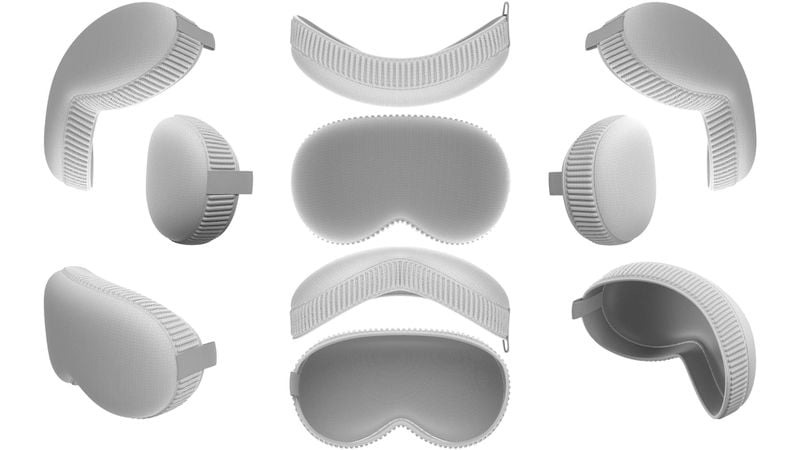A seemingly trivial iPhone accessory leak potentially reveals monumental clues into Apple’s concealed augmented reality (AR) roadmap and smart glasses future.
Dubbed the Vision Pro Cover, this mystical iPhone 15 case apparently packs front-facing depth sensors and LiDAR scanners specially tailoring the handset for advanced AR experiences.
While unconfirmed officially, such a peripheral hints mammoth AR intentions from Apple as it grooms the iPhone into our interconnected spatial computing handler.
How The Vision Pro iPhone Case Works
Details remain sparse currently on the Vision Pro Cover based on leaks not endorsed publicly by Apple yet.
However, the case apparently features an array of front-facing cameras, depth sensors and LiDAR modules not present on iPhones natively.
This supplemental hardware unlocks enhanced environmental scanning abilities for the iPhone. The Vision Pro Cover reportedly facilitates:
- Precise spatial geometry captures
- Accurate depth measurements
- Improved object occlusion capabilities
- Fluid world meshing & mapping
Collectively, such upgrades enable iPhones housing the Vision Pro Cover to reconstruct physical surroundings in richer 3D detail photographically.
Doubling Down on LiDAR Integration
In many ways, this iPhone case formalizes and expands a LiDAR sensor strategy Apple initially introduced minimally across its Pro mode iPhone 12 models in 2020.
However, rather than deeply optimizing iOS experiences around this unique depth-sensing hardware natively, Apple so far simply adopted LiDAR photography peripherally.
The Vision Pro Cover signals plans doubling down on LiDAR-augmented use cases thanks to a four-fold sensor array gain over the single rear shooter on iPhone 12 Pros and 13 Pros.
An AR Capable Super iPhone?
Why quadruple iPhone LiDAR capabilities suddenly? Augmented reality provides the most logical answer.
This long-rumored Apple AR headset expected possibly next year hinges enormously on its companion iPhone functioning flawlessly as a spatial computing engine and controller.
The Vision Pro Cover may constitute one critical bridge linking iPhone screens to Apple’s purported glasses-based immersive displays downstream by transforming handsets into portable environment mappers primed for AR.
Early AR Testing & App Development
Before contemplating more advanced headset integrations, however, this souped-up Vision Pro iPhone first facilitates exciting innovations and experiments advancing mobile augmented reality in its own right.
Enhanced AR Gaming & Entertainment
From puzzle games like Pokémon GO to more graphics-rich offerings like Minecraft Earth, the iOS App Store already houses hundreds of AR-enhanced gaming options today.
However the Vision Pro Cover’s upgraded room scanning and geometry capabilities unlock much more advanced and immersive iOS gameplay potential.
Titles leveraging Apple’s rumored RealityOS backend could utilize Vision Pro iPhones rendering photorealistic environments overlaying purely digital characters and objects more seamlessly than ever experienced on mobile devices.
Reactive Environment Experiences
Commercial iOS apps stand to gain similar augmentations spanning utilities, education, retail and creativity leveraging their real-world surroundings through Vision Pro iPhones in incredible new ways.
Imagine a Star Walk-style astronomy app identifying precise celestial objects based on exact vantage point and orientation.
Or geology software digitally exposing underground mineral composition mapped to terrain simply aiming phone around.
The Vision Pro unlocks planet-scale possibilities previously hampered by mobile hardware limitations.
Mirrored Reality Helpers & Complications
More practical augmented environment integrations will inevitably invite deeper complications, however.
As digital objects mirror our physical environments more comprehensively, so too must governance confronting complex new privacy, personal space and reality perceptivity considerations they manifest.
Apple holds responsibilities ensuring augmented worlds feel secure for consumers beyond just hardware and app capabilities.
Paving the Road to Apple AR Glasses
While buoyed mobile use cases already command attention alone, the Vision Pro Cover’s most seismic implications likely culminate anticipated Apple smart glasses projected to launch as early as 2023.
This niche iPhone case iteration plausibly constitutes critical developmental scaffolding erecting Apple’s larger wearables AR ecosystem.
Offloading Core Companion Processing
Instead of self-contained processing, Apple’s glasses expectantly offload demanding computing like spatial mapping and environment analysis to paired iPhones via high-bandwidth wireless.
Rather than needless duplicating components advancing limited iPhone value, the Vision Pro Cover wisely isolates advanced AR capabilities where most essential – the hypothetical headset itself.
Familizarizing Users With AR Paradigms
Additionally, introducing consumers to augmented environments through iPhone apps lays crucial groundwork acclimating audiences towards similar glasses-based experiences faster.
Building AR comfort via iPhones first allows Apple subsequently transitioning users already familiar with mirrored world interactions to its complementary headgear basically plug-and-playing the same RealityOS framework.
Seeding Developer Momentum
Cultivating an early developer community tinkering with augmented apps also jumpstarts critical momentum Apple requires perpetuating its headset ecosystem.
The long-view gambit trades near-term case sales revenue for Hopefully garnering essential platform support now from key innovation partners later as smart glasses arrive.
The Vision Pro Privacy & Security Imperatives
Yet in pursuing this AR-driven future, the Vision Pro also demands extreme data sensitivity ensuring user protections and trust.
Augmenting personal environments creates incredible helpful opportunities but simultaneously risks real harms absent thoughtful safeguards around privacy.
Spatial Mapping Hazards
For example, silently mapping private living spaces, storing such data externally and possibly sharing 3D room models poses more privacy concerns than legacy photos ever presented.
Apple risks significant breach of trust dilemmas if ambiguities exist around Vision Pro environment archiving policies and access controls.
Data & Access Governance
Preventative measures ensuring users retain complete authority over copied spaces and discretion sharing seem essential building user faith.
Transparent device analytics dashboards detailing exactly what environments Vision Pro models and when also provides some easily accessible protections.
Securing AR Cloud Ecosystems
As multi-user augmented worlds emerge conceptually, thorny challenges likewise arise around safely managing these virtual environments at global scale.
Malicious actors digitally vandalizing or endangering others now assumes spatial computing ramifications requiring thoughtful infrastructure governance contemplated well before productization.
Is Apple Ushering In An AR Revolution?
Between the Vision Pro Cover, anticipated AR headset, and RealityOS platform, signs seem to indicate Apple converging key capabilities delivering an iPhone-quality spatial computing breakthrough finally.
By centralizing the environment scanning burden upon shoulders of iPhones already ubiquitous, Apple steers clear platform sustainability challenges that hindered previous attempts marrying smartphones with smart glasses practically.
However beyond technical feats alone, Apple holds a philosophically greater burden articulating and safeguarding the privacies and securities augmented existence introduces if their grand AR unification vision succeeds at global scale.
Ultimately this responsibility rests upon Apple’s shoulders demonstrating to consumers, regulators and competitors alike that spatial world freedom can thrive absent real world oppression when carefully shepherded.










Add Comment